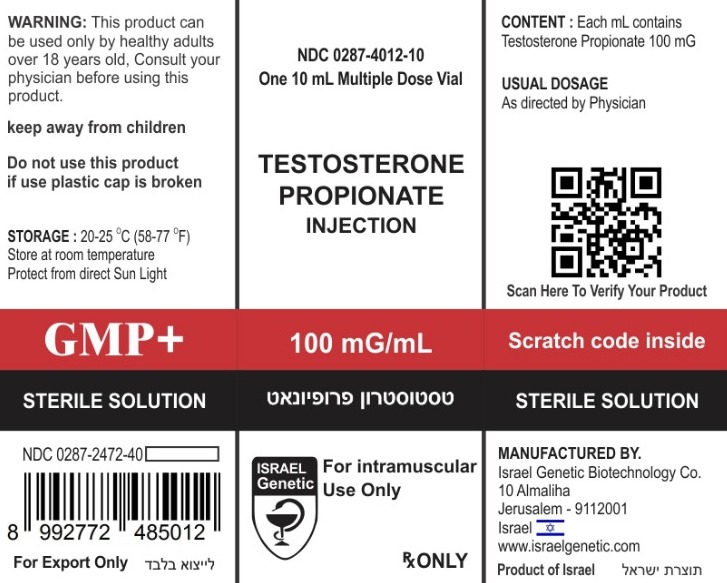
Testosterone Propionate is clear, colourless, oily liquid for Intramuscular injections. Each ml contains 100 mg of Testosterone Propionate. Insoluble in water; freely soluble in alcohol, in dioxane, in ester, and in other organic solvents; soluble in vegetable oils. Its empirical formula is C22H32O3 and has molecular weight of 344.49.
100mg/ ml, 10 ml.
The effects of testosterone in humans and other vertebrates occur by two main mechanisms: by activation of the androgen receptor /directly or as DHT/, and by conversion to estradiol and activation of certain estrogen receptors. Free testosterone is transported into cytoplasm of cells, where it can bind to the androgen receptor, or can be reduced to 5-a dihydrotestosterone by the cytoplasmic enzyme 5-alpha reductase. DHT binds to the same androgen receptor even more strongly than testosterone, so that its androgenic potency is about 5 times that of free testosterone. DHT-receptor complex under goes a structural change that allows it to move into the cell nucleus and bind directly to specific nucleotide sequences of the chromosomal DNA. The areas of binding, called hormone response elements, influence transcriptional activity of certain genes, producing the androgen effects. Androgen receptors occur in many different tissues of the body, and both males and females respond similarly to similar levels. Greatly differing amounts of testosterone prenatally, at puberty, and throughout life account for a share of biological differences between males and females.
MALE: Replacement therapy in castrated adults and in those who are hypogonadal due to either pituitary or testicular disease.
FEMALE: Control of carcinoma of the breast in post-menopausal women.
Males: The most common dosage is 50 100 mg, every day or every other day and total weekly dosage would be in the range of 300-400 mg.
Females: 50-100 mg 3 times in a week for treatment of breast cancer.
Hypercalcemia may occur in immobilized patients. If this occurs, the drug should be discontinued. Prolonged use of high doses of androgens (principally the 17-a alkyl-androgens) has been associated with development of hepatic adenomas, hepatocellular carcinoma, and peliosis hepatis, which all potentially life-threatening complications. Geriatric patients treated with androgens may be at an increased risk of developing prostatic hypertrophy and prostatic carcinoma although conclusive evidence to support this concept is lacking.
Edema, with or without congestive heart failure, is a serious complication in patients with pro-existing cardiac, renal or hepatic disease. Gynecomastia may develop and persist in patients being treated for hypogonadism. This product contains benzyl alcohol. Benzyl alcohol has been reported to be associated with a fatal “gasping syndrome“in premature infants. Androgen therapy should be used cautiously in healthy males with delayed puberty. The effect on bone maturation should be monitored by assessing bone age of the wrist and hand every 6 months. In children, androgen treatment may accelerate bone maturation without producing compensatory gain in linear growth. This adverse effect may result in compromised adult stature. The younger the child is the greater the risk of compromising final mature height might be.
Patients with benign prostatic hypertrophy may develop acute urethral obstruction.
Priapism or excessive sexual stimulation may develop. Oligospermia may occur alter prolonged administration or excessive dosage. If any of these effects appear, the androgen should be stopped and if restarted, a reduced dosage should be utilized. Testosterone Propionate should not be used interchangeably with Testosterone propionate because of differences in duration of action.
Known hypersensitivity to the drug
Males with carcinoma of the breast
Males with known or suspected carcinoma of the prostate gland – Women who are or who may become pregnant
Patients with serious cardiac, hepatic or renal disease
Androgens may increase sensitivity to oral anticoagulants.
Dosage of the anticoagulant may require reduction in order to maintain satisfactory therapeutic hypoprothrombinemia. Concurrent administration of oxyphenbutazone and androgens may result in elevated serum levels of oxyphenbutazone. In diabetic patients, the metabolic effects of androgens may decrease blood glucose and, therefore, insulin requirements. Testosterone Propionate is not recommended for use in nursing mothers.
The following adverse reactions in the male have occurred with some androgens:
Endocrine and urogenital: gynecomastia and excessive frequency and duration of penile erections.
Oligospermia may occur at high dosages.
Skin and appendages: hirsutism, male pattern of baldness, seborrhea, and acne.
Fluid and electrolyte disturbances: Retention of sodium, chloride, water, potassium, calcium, and inorganic phosphates.
Gastrointestinal: Nausea, cholestatic jaundice, alterations in liver function tests, rarely hepatocellular neoplasms and peliosis hepatis.
Hematologic: Suppression of clotting factors II, V, VII, and X, bleeding in patients on concomitant anticoagulant therapy, and polycythemia.
Nervous system: Increased or decreased libido, headache, anxiety, depression, and generalized paresthesia.
Allergic: Hypersensitivity, including skin manifestations and anaphylactic reactions.
Miscellaneous: Inflammation and pain at the site of intramuscular injection.
Acute toxicity of intramuscular Testosterone is very low. In the event of inadvertent administration of multiple doses, no acute toxicity risk is to be anticipated.
Store in a dark, dry place. Keep away from children.
1x10ml glass vial
Copyright © ISRAEL GENETIC 2020 | All Rights Reserved